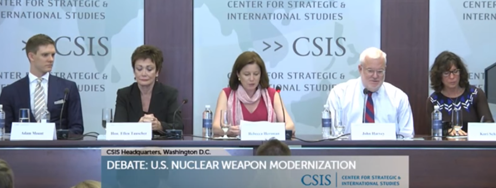The Nuclear Cut at the Deficit
This week, Senator Tom Coburn (R-OK) released "Back in Black," a $9 trillion plan to reduce the U.S. national debt over ten years. In it, he proposed saving $79 billion by cutting the nuclear arsenal to roughly 1,220 deployed nuclear warheads (from the current level of 1,968). His proposal could help put the United States on a better fiscal and strategic footing by getting greater savings out of deeper defense cuts.
The proposal is already raising eyebrows around Washington. A conservative senator who voted against New START is calling for deep cuts to the U.S. nuclear stockpile because he believes it’s what the country can afford. It comes just days after the Vice Chairman of the Joint Chiefs of Staff questioned the need for the nuclear triad. By suggesting moving to a nuclear arsenal of 1,200 strategic warheads, Sen. Coburn is also aligning his budget principles with the advice of experts who believe the U.S. can meet its security needs and those of its allies with a smaller nuclear force.
The Details
The nuclear weapons portion of Sen. Coburn’s 10-year proposal says in full:
Reduce Nuclear Weapons Force Structure ($79 billion)
This option would reduce the size of the nuclear weapon stockpile to levels within the START treaty limits and make the following changes:
- Reduce the size of the Intercontinental Ballistic Missile (ICBM) force from 500 to 300.
- Maintain a 1,100 nuclear weapon reserve.
- Reduce the size of the ballistic nuclear submarine fleet from 14 to 11.
- Maintain 40 strategic bombers and delay the purchase of new bombers until the mid-2020s.
Deeper Nuclear Cuts
Implicit in his budget proposal, Sen. Coburn is suggesting cuts to the US nuclear force down to about 1,220 deployed strategic warheads within 10 years. Here’s the math:
- 300 ICBMs with one warhead
- 40 bombers attributed with one warhead
- 880 warheads on 11 Ohio-class subs (20 missiles per boat with 4 warheads each)
- ----------------
- 1,220 total strategic deployed warheads (with 1,100 in reserve)
This would be the smallest number of U.S. nuclear warheads since 1955. It represents an 80% cut from the 1991 START treaty ceilings, and almost a 25% cut beneath New START.
Interestingly, Sen. Coburn’s proposed total arsenal is in line with proposals for a new arms control treaty with Russia. Ambassador Steven Pifer of Brookings has suggested that the U.S. should pursue nuclear reductions with Russia down to 1,000 deployed strategic warheads, with no more than 2,500 total warheads per side. Such numbers would easily allow for the U.S. to deter nuclear attacks on itself and its allies.
Where Do Nuclear Savings Come From?
Savings in the Coburn plan seem to stem mainly from cutting deployments and operational budgets over the near term. Intercontinental Ballistic Missiles (ICBMs) bear the brunt of the cuts, although the proposed submarine cuts have more potential for budget savings.
ICBMs: The U.S. deploys 450 ICBMs. Sen. Coburn suggests cutting 150 missiles, allowing the U.S. to save operational costs (personnel, equipment, etc.) associated with them. It’s unclear if the proposed ICBM cut would lead to three missile wings with 100 ICBMs each or, by shuttering a wing, two missile wings with 150 each. Both could yield some savings in the operational budget, but the latter would be more cost effective. Given that the Minuteman III was just overhauled to last beyond 2030, an updated Coburn plan could find millions in near-term savings by putting off plans to replace the missile.
Submarines: Sen. Coburn proposes cutting the ballistic missile submarine (SSBN) force from today’s 14 to 11. It’s unclear if he means cutting the current Ohio-class fleet or if he wants to reduce purchases of the “Ohio replacement” (SSBNX). Sen. Coburn’s 10-year timeline suggests cuts to the Ohio fleet. Under the Navy’s schedule, the first Ohio sub retires in 2027 and the first SSBN(X) enters service in 2029. Thus, to get to a fleet of 11 ballistic missile subs in 10 years, the Navy would have to put three Ohio-class submarines into retirement – saving funds in the operational budget. In the long-term, the Navy would likely trim its SSBN(X) buy from 12 to 11, saving $5 to $8 billion by dropping the last sub off the production line (which is to be purchased in 2033).
Bombers: The U.S. has 60 bombers with nuclear missions – 16 B2s and 44 B52-Hs. Sen. Coburn suggests delaying Air Force plans for acquiring a new long-range bomber to replace the B52 until the mid-2020s. By consequence, his 10-year cut of 20 bombers would fall on the aging B52 fleet. Similar to ICBM cuts, such a bomber reduction could be distributed between the two bomber wings with nuclear-capable B52s. Greater cost savings to the operations budget might be realized if the Air Force consolidated its B52 nuclear mission at one base.
Reserve: Sen. Coburn also proposes reducing the nuclear weapons reserve to 1,100 warheads from the current 2,850. This would likely save money, but how much depends on what warheads are removed from the reserve. Much of the stockpile is scheduled for an expensive overhaul, or Life Extension Program. Budget savings could be found by removing warheads from the reserve that have not yet been overhauled.
Conclusion
At day’s end, Sen. Coburn’s proposal will most likely be a conversation starter. It could help bring attention to an area of the defense budget that makes sense to cut, and spur pundits and policy wonks into talking about how nuclear cuts make fiscal and strategic sense.
For that purpose, it’s a smart move. Now it’s time to flesh out the budget details.




